Heather King's Blog, page 4
July 22, 2018
The Beauty of Croome ~ Part Three
The Park and Gardens
Croome Park is situated approximately nine miles from Worcester, five from Pershore, two from the village of Severn Stoke, eight from Tewkesbury, ten from Malvern Wells and sixteen from Cheltenham. There are two drives to the house, approached via the Worcester Lodge, not far from the village of Croome where ‘there is a good Inn, for the accommodation of visitors…’ In the 6th Earl’s time there were two lodges here, ‘…sheltered beneath the pleasant shade of evergreens…’ One remains, built of Bath ashlar in 1801 and now Grade II listed. Most likely by James Wyatt, it has two storeys and iron gates to the side. The visitor can also approach this gate from the village of Severn Stoke, and enjoy the panoramic view across the park as well as a glimpse of the Temple. Not too far distant from the Worcester Lodge, and a third of a mile away are the kennels, beyond which lies Menagerie Wood. In the eighteenth and early nineteenth centuries, there was a Menagerie and Aviary, for which Adam created an ambitious design in 1780, although in the end only an ashlar front was added to the western face of the Keeper’s House, now contained within the nineteenth century brick-built kennels compound. It has a projecting pediment in the centre above a recessed archway, with a large tripartite window from which visitors viewed the animals. There are also two balustrade arches, similarly set back, on either side. The Menagerie was situated about a mile’s walk from the Island Pavilion on the lake. The wood was home to several exotic birds, including a Golden Pheasant.
The drive takes an easterly course to the north of the lake and along the Croome River, thence to curve in a southerly direction towards the north front of the house. The ‘Punch Bowl Gates’, now known as the Worcester Gates and also Grade II listed, stand at about the midway point of this west drive. Restored in recent years, they are set between ashlar piers linked by shallow arches and topped by Coade stone urns. Built in the 1760s, they were redesigned by James Wyatt in 1794.
The second drive is the London Road, from Pershore – so named, according to legend, from the number of pear trees to be found in the vicinity. Once known as the London Lodge, it is now deemed the Pershore Lodge or, commonly, as the London Arch. A Grade II listed Triumphal Arch of Bath stone, it is supported by Ionic pillars and decorated with two figures, representing morning and evening. It is probable it was originally designed by Robert Adam in 1759 and later altered by James Wyatt about 1800. The stone lodge was redesigned circa 1877 and lies about 400 metres from the gateway. The original highway was diverted by Brown to a route outside the park; thus the drive follows the old road in a straight course across a lawn for perhaps 150 metres before sweeping downwards towards the south and the north front of the mansion. This drive now serves the private gardens and Stables Cottages, passing the old Gardener’s Cottage. The modern visitor continues around the tight bend by the Arch and travels a few hundred yards to the National Trust Reception area. The London Arch was the main entrance to Croome, although William Dean gives it as his opinion that the better approach is from the Worcester Lodge.
A leafy path through Wilderness Walk brings today’s visitor to a gateway. To the right is Horse Close, two conjoined meadows where dogs can run free under proper control and supervision – a wonderful boon to the dog owner and may this author offer heartfelt thanks to the National Trust for such a resource. Turning to the left brings the visitor, after a walk of just a few yards, to the Church of St. Mary Magdalene. It is beautifully carved inside and well worth a visit. From here the most glorious views can be obtained across the park, of the Panorama, the Temple [Greenhouse] and Croome Court nestling in the bowl surrounded by woodland and hills.
In the shrubbery not far from the Church is a curious egg-shaped building with a thatched roof. A pond lies nearby, brick-edged and shallow. This is the Ice House, where ice was stored in the winter months to serve the Earl of Coventry’s household. When low temperatures caused the water in the pond to freeze, the ice was broken (not a popular task, called ‘skimming’) and taken to the ice house, where it was packed in straw. I would not fancy it in my syllabub! The building is eighteen feet tall and the ice chamber is thirty-three feet from top to bottom, two thirds of it underground. The base is shaped like a keel, to facilitate dispersal of meltwater. Facing north-east and shaded by the shrubbery, it is situated on a well-drained ridge. When the National Trust took over the Park, the Ice House was in a terrible state of disrepair. Goose grass and brambles clambered all over the pond and the house was tumbledown, having lost half of its’ bricks while the roof wore a cap of weeds. Restoration was completed in 2016 and it now presents a very different picture.
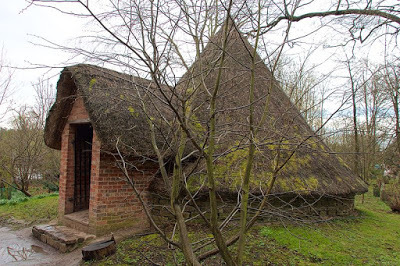 Croome Court Ice HouseCroome_Court_Ice_House_2016_ Photograph by Mike Peel (www.mikepeel.net)
Croome Court Ice HouseCroome_Court_Ice_House_2016_ Photograph by Mike Peel (www.mikepeel.net)With the fidgets removed from Excited Pooch’s paws, take a right-handed path near the Church and enjoy a scenic meander through the delightful Shrubbery. When the author last visited, some years ago, this was being systematically cleared and replanted by Croome’s team of gardeners and volunteers. What a marvellous job they have done! To either side of the gravel path are luxuriant specimens, reinstated as they were in William Dean’s day thanks to the extensive records kept. In among are various pieces of statuary – some found when the lake was dredged and now restored! One of these is an inspiring figure of Pan; another is a wonderful urn, which was found in pieces, buried in undergrowth below the pedestal, and painstakingly put back together like a jigsaw.
Wandering through shady woodland, you then come to open parkland and the Temple Greenhouse, boasting six Doric columns and pediment carved with a basket and flowers, by Sefferin Alken. Once fitted with sash windows which could be lowered, it is now glassed between the plain pillars to form the greenhouse. It commands a glorious vista across the Pleasure Grounds, with the winding river – created by Brown to drain the marshy soil which existed here before – swelling into the Lake and providing a living tapestry as Canada Geese, swans and other birds nest and squabble. It is a lovely spot in which to sit and contemplate – or plot the next novel!
 Temple Greenhouse
Temple GreenhouseFollowing a suitable sojourn in one of the deck chairs or inside the Temple, the path takes the visitor towards the Lake. A right turn will take the energetic towards the aforementioned Worcester Gates and via bluebell woods a public footpath can be accessed across the parkland to view the Park Seat, designed by Robert Adam in 1766 and then built in a more simplified version in 1770. Also known as The Owl’s Nest, it is a pedimented archway on Tuscan columns flanked by attached giant columns, fronting an alcove from where a superb view of the park can be obtained.
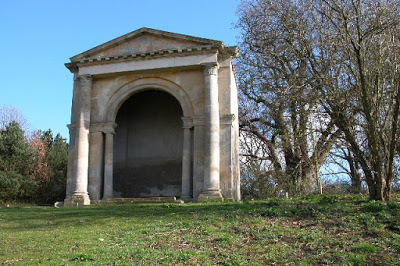 Park Seat/The Owl's Nest
Park Seat/The Owl's NestPhilip Halling / Croome Landscape Park / CC BY-SA 2.0
Another public right of way can take the walker back to the London Arch, and the Croome visitor can join another path to the Rotunda, where there is a choice of routes, either to the Court or to the Church.
Returning to Energetic Pooch by the Lake, a left turn follows the carriage drive from the Worcester (Punch Bowl) Gates along the north side of the river directly to the house. Continue across the river a little further on to follow the south bank to the Chinese Bridge and the Court, or, to the right, one path encircles the Lake to return to the bridge, while a second joins the Park Seat public footpath. The handsome Dry Arch Bridge, with a stone balustrade, carries the carriage drive over an underpass (recently cleared) that connects the two Pleasure Grounds on either side of the river.
Just beyond the Worcester Drive, an iron bridge (circa 1972) replaces the original ferry across the river to the Lake. A right turn takes the visitor to the Sabrina Grotto, a rocky structure following the curve of the water. Rough, arched openings front low bench seats and a statue of Sabrina, also restored, lies in state before it. Originally, water poured from her urn and was lit with a lamp at night. Begun in 1765, by the 1780s the Grotto was covered in shells, coral, fossils and crystals.
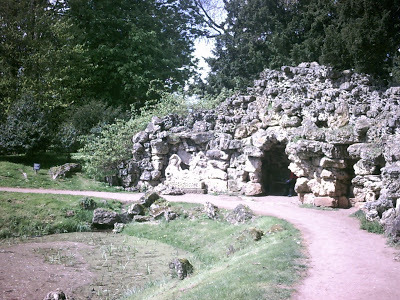 The Grotto
The GrottoFurther along, two iron bridges of 1806 cross to the second Island. The Temple Pavilion, a summer-house probably designed by Adam, circa 1776-8 is a peaceful spot, designated in 2018 as a place of silence where visitors are invited to switch off their phones and listen.
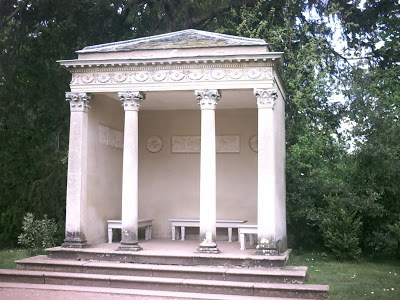 Island Pavilion
Island PavilionHaving crossed the second bridge, turning right takes one to the other end of the Lake, where Brown’s boat-house is no more, beyond a few foundations, but quotations from the Hortus Croomensis further enliven a most inspiring walk which can return to the Grotto or pass through a gate into the park and following a mown path across the grassland join a gravelled path near the Chinese Bridge (by William Halfpenny and recently refurbished and restored). Conversely, a left turn by the gate brings the visitor by a circular route following the bank of the river to reach the Chinese Bridge from the opposite direction. The path also continues to the carriage splash (in the process of restoration) at the farthest tip of the river near the Park Seat.
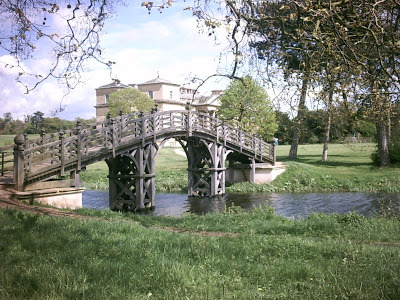 The Chinese Bridge
The Chinese BridgeA short walk across the lawns brings the visitor to Croome Court itself. By following the path around the south side of the mansion and either continuing along it through the Home Shrubbery, or taking a grassy footpath beside the Ha-ha, at the top of the slope you will find the Rotunda. Designed by Brown in 1754-7, this is surrounded by spreading Cedars of Lebanon and protected from the park by said Ha-ha. An iron gate, opening on to a flight of narrow steps, takes you up to the circular, Bath stone building. Grade I listed, it boasts a shallow dome, is set on a low, circular stone plinth with shallow steps. The door and five windows have pediments and carved Portland stone panels designed by Adam above those. The door is in two narrow sections, leading to an interior decorated in delicate plasterwork panels by Vasselli, 1761. Inside, the dome is coffered (it has ornamental sunk panels). Described by William Dean as ‘fitted up as a summer evening apartment’ and ‘furnished with sofas’, it sits within its’ ‘woody crescent’ it commands ‘a view, which, in all that constitutes a landscape, rich, diversified, extensive, and well-combined, is rarely exceeded.’ Purchased in 2007 by the Croome Heritage Trust, restoration was undertaken thanks to a grant, while the National Trust has restored the outside.
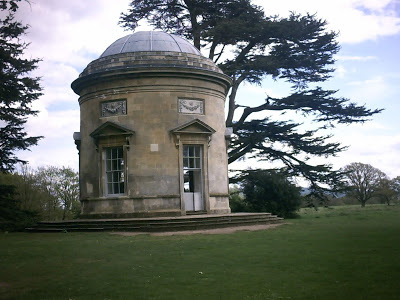 The Rotunda, with Cedar of Lebanon behind
The Rotunda, with Cedar of Lebanon behind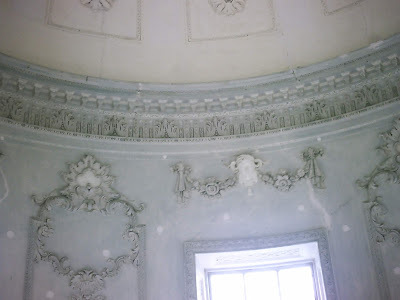 Rotunda dome and plasterwork Cypress and cedar trees around the Rotunda were planted when it was built and are now truly venerable specimens. The Home Shrubbery has also been returned to its’ original planting, when it contained gold and silver variegated holly, a North American sassafras tree, a maiden-hair tree (‘acknowledged as being the finest in the kingdom’), a yellow-flowering horse chestnut, an immense evergreen oak, thirty foot high magnolias and a Virginian (red) cedar. In the centre of a small lawn, on Jubilee Day 1809 the one-year-old Hon. George William Coventry, eldest son of the then heir to the Earldom, planted an acorn. By 1824, the oak was thirty feet tall and two feet around the trunk. Next time I visit, I shall look out for this tree to see it still stands – and how big it is now, almost two hundred years later. A Tulip tree, more cypress, an Oriental plane and a variety of imported shrubs and flowers were also planted here as part of the 6thEarl’s great vision.
Rotunda dome and plasterwork Cypress and cedar trees around the Rotunda were planted when it was built and are now truly venerable specimens. The Home Shrubbery has also been returned to its’ original planting, when it contained gold and silver variegated holly, a North American sassafras tree, a maiden-hair tree (‘acknowledged as being the finest in the kingdom’), a yellow-flowering horse chestnut, an immense evergreen oak, thirty foot high magnolias and a Virginian (red) cedar. In the centre of a small lawn, on Jubilee Day 1809 the one-year-old Hon. George William Coventry, eldest son of the then heir to the Earldom, planted an acorn. By 1824, the oak was thirty feet tall and two feet around the trunk. Next time I visit, I shall look out for this tree to see it still stands – and how big it is now, almost two hundred years later. A Tulip tree, more cypress, an Oriental plane and a variety of imported shrubs and flowers were also planted here as part of the 6thEarl’s great vision.To the right of the path on the return journey to the house, a side walk led to the Dairy, ‘presenting all the proper and characteristic appearance of unsullied purity and refreshing coolness’. It had marble troughs for the milk, Dutch tiles on the walls and all the utensils were ‘of best Wedgewood ware’.
Not far from the Dairy was the Hot House, where such exotics as cinnamon, palms, coffee and the bread-fruit tree were nurtured. Adjoining the Hot House and extending for almost half a mile, was and is the Hot Wall, where various climbers, hardy greenhouse plants, dwarf shrubs and ‘choice flowers’ are all grown. Positioned to maximize the warmth of the sun, it was also heated by five underground furnaces at intervals along the northern face. These were discovered during restoration. Hot houses were added by Capability Brown to grow vines, peaches, melons and pineapples. There were various glass houses, pineapple pits, forcing beds, tomato and orchard houses already in existence.
Apart from the glass houses and a circular pool with a sun dial, designed by Adam, the garden was largely untouched by Brown. It had been begun by Ann Somerset, wife of Thomas, 2nd Earl of Coventry, and William Shenstone in the late seventeenth century. The early eighteenth century saw the addition of a kitchen garden during the time of the 4thEarl, Gilbert. In due course, this became the Walled Garden. With the alteration of the walls from a conventional square to the oblique shape now in existence, the garden became over seven acres in size and possibly the largest such garden in eighteenth century Europe.
The Walled Garden is in private ownership and not a part of the National Trust. It is open to the public at weekends and bank holidays only.
The Outlying Park Features
The Panorama Tower is a Grade I listed building designed by Wyatt in 1801, based on a similar conception by Adam of the 1760s. A round temple, situated on Knight’s Hill near the village of Kinnersley, on the edge of the park, it was actually built 1805-12. The lower section has four groups of Tuscan columns spaced between solid walls containing niches set beneath blank panels of Bath stone. A balustrade with solid sections surrounds the upper level, reached by a circular staircase within, which provides a 360 degree viewing platform. From here, glorious views can be obtained across part of Croome Park to Worcester Cathedral and the Malvern Hills, over the beautiful Worcestershire and Gloucestershire countryside. The domed roof sits on a windowed upper storey like a pill-box hat. In a poor state of repair, it was restored after the National Trust acquired it in 2009 and is separated from Croome Park by the M5 motorway.
Pirton Castle
Designed as a Gothic ruin by James Wyatt in 1801, Grade II Pirton Castle sits on a ridge known as Rabbit Bank at the village of Pirton to the north of the park and intended to be viewed from Croome. Built of ashlar, it features a length of wall partly covered in ivy and an off-set tower. Cedars of Lebanon planted at the time now form a 200-year-old backdrop to a folly which appears more like a film set than a ruin. The castle, along with several acres of grassland, was bought by the National Trust in 2009 and restoration (removal of harmful vegetation, repointing the stonework and rebuilding broken masonry) was completed that summer.
Dunstall Castle
Located at Earl’s Croome, Dunstall Castle was designed by Robert Adam as a folly in the style of a Norman ruin in 1766-7. Grade I listed (according to the NT website), it consists of a central round tower with a wide, arched doorway set high up. A wall links it to a similar tower on the eastern side with a very large double-layered archway. A second, shorter wall, with a shallow gable over an intentionally ruined window, adjoins another, square tower. There is a trefoil-shaped top to the opening. The central tower contains a steep, spiral staircase; as with the Panorama Tower, a viewing platform commands vistas over Croome Park. In danger of becoming a true ruin, the castle was purchased by the National Trust in 2010 and work ensued to restore the central tower and staircase.
 Dunstsll Castle
Dunstsll CastleI really hope you have enjoyed this virtual tour of Croome Court. It is the perfect place for a day out ~ or a morning or even just a couple of hours. I can thoroughly recommend it if you have the chance to go!
Until next time, all the best,
Heather
All photographs © Heather King unless otherwise states and may not be reproduced without written permission of the author.
© Heather King

Published on July 22, 2018 11:27
July 3, 2018
The Beauty of Croome ~ Part Two
The House
Croome Court is built in ‘warm-coloured Bath ashlar’, a Palladian mansion with two flights of steps leading to the north front and a pedimented portico to the south flanked by Coade stone sphinxes.
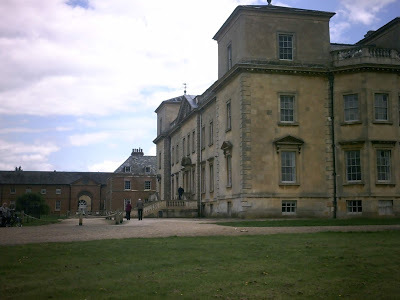 North Front © Heather King
North Front © Heather King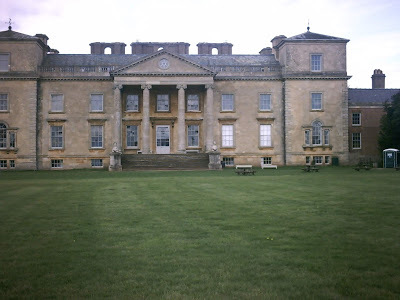 South Front © Heather King
South Front © Heather KingArchitecturally, it has eleven bays on each side, a basement and a balustrade to the upper floor. The roof is slate, being pyramidal over the corner pavilions, and has three sets of two chimneys. On both north (entrance) and south (garden) fronts, the central section has three bays, there being a broad sweep of steps to the south portico. The staircases on both sides are guarded by balustrades, the southern door having a cornice on consoles above. The north front has a Doric doorway beneath a smaller pediment and carries a heraldic cartouche by Adam. The corner towers on this side have piano nobilewindows beneath their own pediments, while Venetian windows face the garden side. The southern tetrastyle (meaning four) portico boasts unfluted Ionic columns and confers a grand façade on the building. The two-storey Red Wing is attached to the house on the eastern side (shown to the right of the second photo) and has a newly renovated slate roof. Beyond the service wing, connected by a wall, lies the stables and stable courtyard, now used as holiday accommodation. The stables were open to the south, being enlarged and rebuilt by Brown circa 1752 from the original layout planned by Francis Smith in 1714 and erected in 1716-19. They were later rebuilt again by Adam, being also brick and with three pedimented entrance arches, stone-faced on the inside. Attached on the eastern side is a groom’s cottage dating from the mid to late eighteenth century. Both stables and house are Grade II listed. Private gardens are situated further to the east, as well as the Walled Kitchen Garden – seven acres, all told – of which more later.
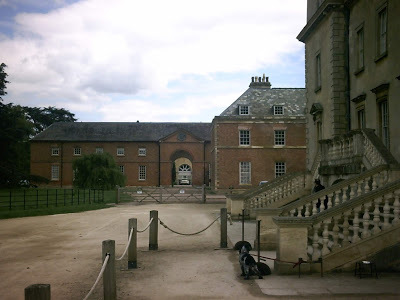 Red Wing and Stable Courtyard, Stables on left © Heather King
Red Wing and Stable Courtyard, Stables on left © Heather King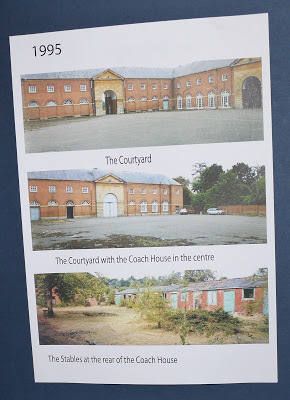 The Stables and Coach-house Poster © NT Croome
The Stables and Coach-house Poster © NT CroomePhoto courtesy Morton S. Gray
Interior
With Croome’s chequered history, much of the interior has been lost, although the National Trust is working hard to restore it to its’ former glory. Many items have been returned to furnish the rooms they once graced. About a fifth of the original furnishings were retained by the Croome Estate Trust following an auction which took place in 1948. The rooms are of handsome rather than splendid dimensions, designed for practical use. The 6thEarl, according to Head Gardener William Dean, was given to saying to his friends, “Go to Blenheim for grandeur; but come to Croome for comfort!”
Capability Brown worked on the interior design, in association with Robert Adam from 1760. One suspects he took a more backward seat from that date. Plasterwork was executed by Francesco Vassalli, Robert Adam himself and Joseph Rose. Brown, it seems, was behind the more sober rooms, designing door-frames with straight tops, fine carving and fluted columns; deep, moulded cornices and elaborate chimneypieces – mostly in the Rococo style. He designed both the Entrance Hall, with its’ stuccoed ceiling supported by four fluted Doric columns, and the Saloon behind, reached by a pedimented doorway fronting a cross-corridor. The Saloon, decorated in gold, white and green, boasts a coved ceiling with three plain panels by Vasselli and a doorway with a broken pediment which is flanked by fluted Ionic fireplaces.
 Looking through into the Entrance Hall © Heather King
Looking through into the Entrance Hall © Heather King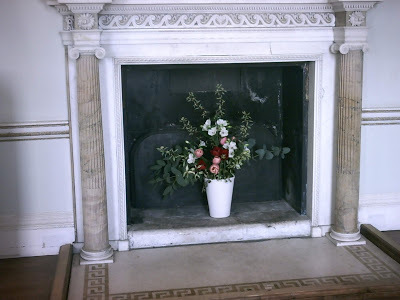 Saloon Fireplace © Heather King
Saloon Fireplace © Heather KingTo the right of the Entrance Hall lies the Billiard Room, where once portraits adorned the walls and a huge table held centre stage. Nowadays it is used for a film introduction to Croome. A flight of stairs lead down to the Basement, where much-needed refreshments may be had in Kitty Fisher’s Coffee House. Kitty Fisher was the famous eighteenth century courtesan who was reputed to have had an affair with the 6th Earl of Coventry. There is also a line of lockers dating from the house’s years as a school, now holding a collection of footwear. Within the Basement were the Housekeeper’s Room, the Butler’s Pantry, the Silver Strong Room, the Wine and Dry Cellars and the Servants’ Hall. A doorway and stairs lead to the Red Wing.
Bypassing the stairs to these nether regions, the visitor passes into the Long Gallery, once known as the Statuary. It is a fine apartment, stretching the full width of the house and with a large bow window at the centre of the west wall. There are beautiful views across the park from here.
 View from Long Gallery © Heather King
View from Long Gallery © Heather KingIt is a bright, airy room and is Robert Adam’s masterpiece here. It was his first ever complete room design. Seventy feet long and twenty-five feet wide, the Long Gallery has an eye-catching elongated octagonal and lozenge design of plasterwork on the ceiling, as well as other moulding by Joseph Rose, and a beautiful white marble fireplace. During the 6thEarl’s time, it was used as a family/morning room and was filled with statues in the various niches set into three walls, mirrors and furniture.
 Moulded ceiling by Joseph Rose, Long Gallery © Heather King
Moulded ceiling by Joseph Rose, Long Gallery © Heather King
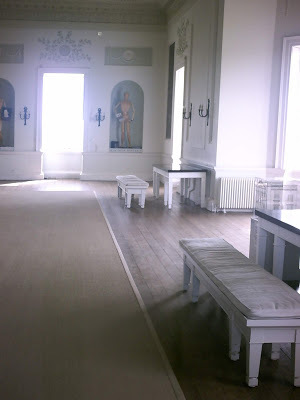 The Long Gallery © Heather King
The Long Gallery © Heather King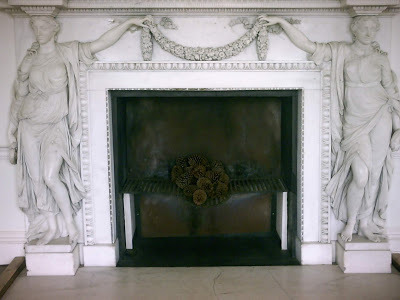 Fireplace, Long Gallery, carved by Joseph Wilton
Fireplace, Long Gallery, carved by Joseph WiltonFrom the Long Gallery, the visitor moves on into the Yellow Drawing Room, where once were displayed a host of valuable paintings, both portraits, landscapes, the Madonna and two pictures of Cleopatra, among others. Two of the most treasured were full length portraits of King George III and His Consort, presented by their Majesties when they honoured Croome with a visit in 1788. It has Rococo plasterwork and a marble fireplace.
From the Drawing Room we come to the Saloon again. A wide wooden door leads out on to the portico and thence to the lawns on the south side. The pair of sphinxes rest on their plinths, guarding the steps with stony aloofness, safe in the knowledge they will still be there after we puny humans have all gone. Portraits of family members used to hang here, including Thomas Coventry, Lord Keeper of the Great Seal, Statesman and lawyer; Lord Thomas Coventry (possibly the former’s son); Maria, Countess of Coventry and her sister, the Duchess of Hamilton. It commands a ‘most delightful prospect’ of the park from its’ windows, over verdant grassland, winding waters and the one-time herd of deer, to the grand sweep of lush woodland.
The Tapestry Room is next, although sadly the whole was moved in 1958 to the Metropolitan Museum of Art in New York. Based on a design by Robert Adam, the room was created between 1763 and 1771. The tapestry, of Gobeline manufacture, had a crimson background and was ornamented with coloured figures to represent the four elements. According to William Dean, it was marked with the names of the artist, Neilson, and the designer, Boucher. The furniture matched the hanging and there were more superbly crafted mirrors. The tapestry and furniture was sold to a Parisian dealer by the 9th Earl in about 1902 and then the fabric of the room – floor, ceiling, chimneypiece, doors, door-frames etcetera were bought by the Samuel H. Kress Foundation in 1949, later to be donated to the Met. Museum. The chair and settee frames have now also been acquired by the museum with the help of the Kress Foundation. They have been recovered with the original upholstery. A copy of the ceiling has now been put in place of the original.
 Tapestry Room, Metropolitan Museum of Art, Public Domain
Tapestry Room, Metropolitan Museum of Art, Public DomainOnly the marble fireplace by John Wildsmith remains of the original Adam Library. The mahogany bookcases were removed to the Victoria and Albert Museum. In William Dean’s day it was ‘appropriately furnished’ and contained ‘a collection of books, not large, but choice’. The 6ht Earl of Coventry was a man of taste and refinement. He would only have the choicest specimens in any collection.
A second door leads from the Library into the main staircase hall. The staircase is not grand, being made of cantilevered stone with an iron balustrade. Crossing the hall, the visitor enters the Lord’s Dressing Room. Today (or at least it did when this author visited), it has the portrait of the 6thEarl by Allan Ramsay – returned to Croome after 76 years – hanging above the fireplace and a magnificent commode (no, not that sort of commode), which was one of Lord Coventry’s most prized possessions.
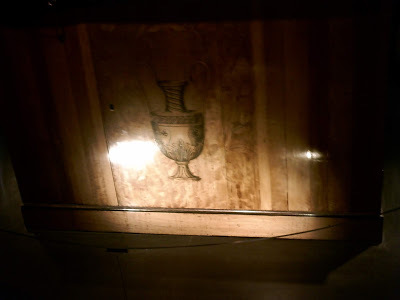 Commode belonging to Lord Coventry © Heather King
Commode belonging to Lord Coventry © Heather KingThe commode is a large cabinet, one of a pair, made by John Mayhew and William Ince, 1759-1803, their showrooms situated off Golden Square in Soho, London. It is made of satinwood and holly, and has a top shelf which slides out, providing a flat surface for the brushing of clothes. It also contains various drawers and is decorated with the raised urns as shown in the photo and other classical images requiring great skill.
The Friends of Croome Park Newsletter of May 2012 informs us that much of the Croome collection was then at Kelmarsh Hall in Northamptonshire, but gradually the items are, thanks to the National Trust, being returned to the house in which they belong. During the 6th Earl’s tenure, the accounts show that over £3,000 was paid by Lord Coventry to two more celebrated furniture makers, for in excess of 1,300 items. William Vile (what a name to be saddled with!) and John Cobb were often commissioned to produce pieces of furniture for Croome. It may not sound a lot in these inflation-ridden times, but it was a lot of money then.
Finally, we come to the Dining Room, a spacious and handsome room, painted by the Hare Krishna movement in the 1970s to 80s. Currently it contains exhibitions of Croome’s porcelain.
 Dining Room plasterwork
Dining Room plasterwork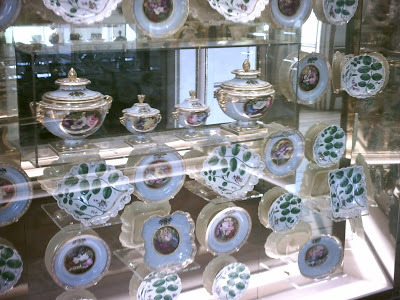 Porcelain Display © Heather King
Porcelain Display © Heather KingThe second floor holds Lord and Lady Coventry’s bedchambers, Lady Coventry’s Boudoir and Dressing Rooms, the Chinese Bedroom and three other bedrooms. There are some interesting artefacts, paintings and furniture on display, including (if I remember correctly) the 6th Earl’s canopied bed, purchased for his marriage to Maria Gunning. Unfortunately, the only genuine parts remaining are the posts and the photograph didn’t come out because of the lack of light. Nevertheless, there are some curious low chairs, a horse’s hoof inkwell, à la Copenhagen’s (which sits in pride of place on a sideboard at Horse Guards) and two equestrian paintings. The most interesting of these is attributed to John Wootton and is entitled The Great Horse or Jack-a-Dandy, circa 1680-1710. Only with a guide can the visitor access the stairway properly to see this enormous painting. Not having a wide-angled lens, this author had to take it in two halves.
 Jack-a-Dandy, The Great Horse, attributed to John Wootton
Jack-a-Dandy, The Great Horse, attributed to John WoottonPhoto © Heather King
The story goes that Sir Henry Coventry, soldier, ambassador and politician, had a wager with his brother-in-law, Sir John Pa[c]kington, on a horse race in which Jack-a-Dandy was to take on Sir John’s horse. The loser was to found charity alms-houses in Droitwich and name them after the winner. Thus the Coventry Charity Alms-houses were founded by Sir John without the honour of his name being given to them. From the Entrance Hall, where it was carefully restored, the painting has been re-hung in its’ historical position and is on long-term loan from The Coventry Charity.
 Armchairs and Pie-crust side-table © Heather King
Armchairs and Pie-crust side-table © Heather KingAnother extremely interesting item is Lord Coventry’s ‘Gentleman’s Exerciser’ or ‘Chamber Horse’, a contraption the 6thEarl is reputed to have used when unable to ride due to the effects of bad winter weather or gout!
As the National Trust says, ‘It is poignant to imagine the 6th Earl in his later life, reduced to taking his exercise in this way, looking out from the Court at his created landscape and unable to ride or walk out over it.’
Layers of wooden boards had springs in between. These compressed beneath the weight of the person and expanded again in a similar action to an accordion. Covered in leather, it had openings in the sides to permit the air to escape on the downward thrust. Holding the arms of the chair, the person used their legs to push up from the floor in a repeated action… not unlike an eighteenth century space hopper!
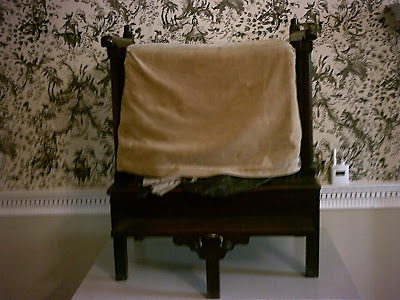 Gentleman’s Exerciser © Heather King
Gentleman’s Exerciser © Heather KingThe second floor is only accessible to the public on guided tours, because it houses the collection which is in store. I am sure it will prove fascinating, and one of these days I shall return to take the tour. There is always so much to do and see at Croome! All photos © Heather King unless otherwise stated
Next time, I shall take you on a tour of the Park.

Published on July 03, 2018 12:33
June 13, 2018
The Beauty of Croome
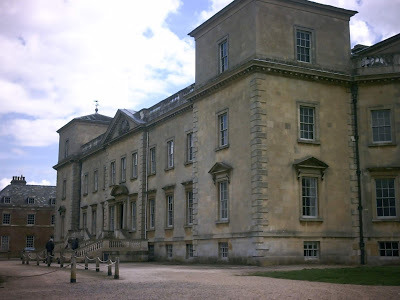
North Front
History of Croome
Croome Court, situated at Croome D’Abitot near Pershore in the heart of Worcestershire, has been the seat of the Coventry family for six hundred years. While the heart of the mansion dates from the 1640s, the house seen today was down to George William, 6th Earl of Coventry. When he inherited the estate in 1751, following the death of his older brother Thomas, he set out to create a ‘place of beauty and artistry’.
 The 6th Earl of Coventry by Allan Ramsay Photo © Heather King
The 6th Earl of Coventry by Allan Ramsay Photo © Heather KingIn 1752, he married the celebrated Maria Gunning, elder of the two famous actress sisters who took fashionable London by storm because of their incredible beauty, and in spite of coming from Dublin and being dreadfully poor. Maria was so popular, she was mobbed whenever she appeared in public. Tragically, she died when only 28, poisoned by the lead in the make-up she used.
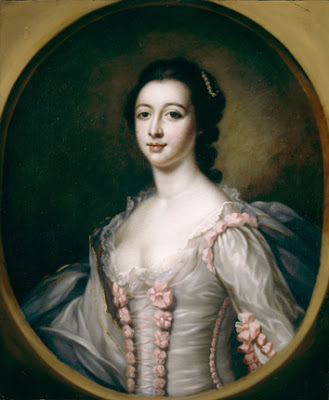 Maria Gunning married the 6th Earl of Coventry
Maria Gunning married the 6th Earl of CoventryCourtesy Wikimedia
However, the history of Croome starts long before the eighteenth century. The Domesday Book records that the manorial rights and much of the land at Croome belonged to the Bishop of Worcester. According to this entry, Croome consisted of one hide of land, three carucates (both measures being equal to about one hundred acres, though accounts differ on this) and Oderic, who held the land for the Bishop, also possessed three villans or slaves for working the land and five bordars, upper domestic servants who waited at their master’s board in addition to other ‘less ignoble offices’. There were also ‘twenty-four acres of meadow and three quarantines [roods] of woodland’. The value was estimated at forty shillings.
I wonder how many thousands of pounds it is worth now!
Following the Norman invasion, the estate passed to Urso D’Abitot, after whom the village was named. William the Conqueror granted Urso forty hides – about four thousand acres – in Worcestershire, besides other manors elsewhere. He was also appointed hereditary sheriff and constable of the royal castles in this beautiful county. Cursed by the Bishop of York (who had previously lost his right to Worcester), for various incursions against the monks of that city, Urso died not long after the building of his castle, his only son following him soon after. Croome therefore passed into the hands of the Earls of Warwick via the marriage of Urso’s daughter, Emma to Walter de Beauchamp.
Held by one Osbern D’Abitot in 1283, the estate then passed through various owners until it came into the possession, via marriage again, of Simon Clare of Kidderminster. It was from Sir Ralph Clare Bart. that Sir Thomas Coventry purchased the property and thus the association of the Coventry family with Croome began.
To return, then, to the 6th Earl’s vision for Croome, George commissioned Lancelot ‘Capability’ Brown, not only to landscape the parkland, the capacity for which he was known, but also as architect for the house. Sanderson Miller, responsible for Hagley Hall and possibly also involved at Croome, given the similarity between the two, introduced Brown to the Earl. Later – after 1760 – the young Robert Adam was employed in the design of interiors and furnishings.
Successive holders of the title were all named George William and from the 7th Earl onwards also held the title of Viscount Deerhurst. However, crippling taxes forced the 9th Earl, who wished to keep the estate intact and not sell part to reduce the burden, to pass the estate into the management of the Croome Estate Trust – which he inaugurated – in 1921. All records prior to this date are held at the Worcestershire Records Office. The 9thEarl (born 1838) was so proud of Croome he did not alter any part of it, although he did keep a stable of sixty horses. He also bred them and won the Grand National in successive years, with full sisters Emblem in 1863 and Emblematic in 1864. George William, son of the 9th Earl, died in 1927 and did not inherit the title, which passed to his son, the 9thEarl’s grandson, also George William. The 10th Earl died during the Second World War, at the Battle of Givenchy in 1940, and was buried there. In effect, his death spelled the end of the Coventry family’s association with Croome, for the Court was requisitioned by the Ministry of Works and leased to the Dutch Government for a year – a possible for refuge from the Nazis for Queen Wilhelmina of the Netherlands – and part of the estate was developed into RAF Defford. The estate was then sold in 1948.
Along with 38 acres, Croome was sold to the Roman Catholic Archdiocese of Birmingham and was turned into St. Joseph’s Special School for boys. In 1979, it was taken over by the Hare Krishna movement and it was during their occupation that the Dining Room was repainted. They left the house in 1984, when various owners with various schemes – golf course, hotel, restaurant, conference centre etcetera – took on custodianship. In 1996, the National Trust took over the landscape park and set about the arduous task of restoration. With this aim, the park was opened to the public.
Then, in 1999, the house returned to being a private family home again when bought by Lawrence Bilton.
Finally – and the old house must have breathed a huge sigh of relief – the Croome Heritage Trust bought the mansion in October 2007. It is leased to the National Trust for 999 years and an extensive programme of restoration has begun. Six rooms, including the Saloon, had been restored, at a hefty cost of £400,000 when Croome Court opened to the public in September 2009. The attached service wing, built of red brick and with the upper floor converted into a private suite of apartments for Lord Coventry in 1799 (by James Wyatt), was then empty and in desperate need of refurbishment and repair. The ‘Red Wing’ is now weather-proof and structurally sound, but still requires a great deal of work to restore it to practical use. Hopefully, one day it will once more be used as a service wing to the main house as originally envisaged by Capability Brown.
 North Front, Red Wing and Stables
North Front, Red Wing and StablesIn the next post(s), I will look at the house and park. Croome is a wonderful place to visit and all the staff friendly and helpful.
Unless otherwise stated, all photos © Heather King

Published on June 13, 2018 14:40
April 17, 2018
Why I Love Historical Romantic Fiction
 Cupid & Psyche, Edward Burne-Jones
Cupid & Psyche, Edward Burne-Jones
There are many reasons why I love reading and writing historical novels. Firstly, I love history. Secondly, I am just a big softie and like nothing better than a Happy Ever After ending.
I began by making a list of things which draw me to my favourite era, the Regency. As it grew, just for fun I thought I would make it a Romantic Fiction ABC. Here, then, is my Top Twenty of why I love Historical Romance novels.
A is for Architecture
I just love Georgian architecture, whether as a London town house or a beautiful country mansion. There is something hugely romantic about the arrangement and shape of windows, pediments and porticoes; of marbled floors and the symmetry of rooms around a central entrance hall; of rococo plaster work on ceilings and mantelpieces, and – far from least – the glorious richness of murals and ceiling paintings.
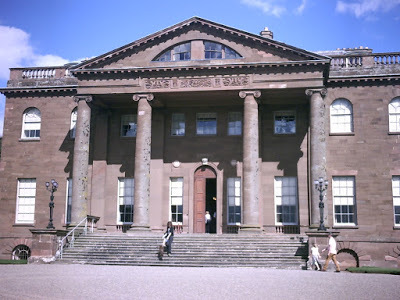 Berrington Hall, Herefordshire
Berrington Hall, HerefordshireB is for Breeches and Top-boots
Some ladies find attraction in Giorgio Armani, Gucci and Boss. Not so this romantic author. For me, men in breeches, neckcloths and elegant coats, with top-boots or Hessians, have a swoon factor the half-naked men depicted on some modern covers just don’t have (not that I don’t appreciate a manly chest, you understand!) The sight of Richard Armitage’s Mr. Thornton will always win the heart over his be-stubbled Guy of Gisburne. Although… ahem.
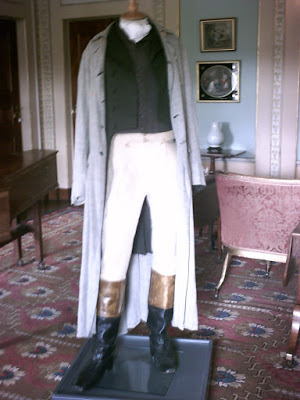 Mr. Darcy's ensemble from 1995 adaptation of Pride & Prejudice
Mr. Darcy's ensemble from 1995 adaptation of Pride & PrejudiceC is for Carriages
There is just something about a four-in-hand and a beautifully turned out equipage that modern cars cannot emulate. Although they were nowhere near as comfortable to travel in (and I appreciate many will disagree with me), cars have nothing to compare with the jingle of harness, the stamp of a shod hoof, the snort of the proud ‘cattle’ poled up. Flying feathers, tossing manes, swinging tails; the glorious, pungent smell of sweat glistening on warm equine hides… ah, sweet bliss to the horse fan!
 The Edinburgh - London Royal Mail,
The Edinburgh - London Royal Mail,J.F. Herring Snr.
D is for Dresses and Drawers
What can be more romantic than beautiful gowns with frills and flounces? I will confess they have never been my idea of comfortable clothing, but I love to see them and certainly wouldn’t mind possessing an elegant riding habit. I love to read a book where the author has taken the trouble to describe what characters are wearing. For me, that is part of the magic of historical fiction – to be carried away to another time, to escape reality for a while. I hope I succeed in sweeping my readers away to the world my characters inhabit.
E is for Elegance
The Georgian era is renowned for its elegance. Georgette Heyer’s heroes appreciate a well-turned ankle, do not leer over some Page 3 girl. Beautiful porcelain, cut glass and tableware; delicate fans, with their own discreet language; pretty frills and fichus; embroidery, lace and silks; the smooth rotation of a perfect waltz… the instances are many. When I have time, reading a well-written novel or watching an historical drama takes me away from the ordinariness of everyday 21st Century life and allows me the illusion such elegant living has not gone for good.
F is for Furniture
Having longed for a Hygena bedroom in my youth, I now appreciate the beauty of hand-crafted wood and especially that of the Georgian age. I love most old furniture, even utility stuff made during WWII. I should love to have a big kitchen with Welsh dressers, solid oak tables and cupboards. Part of the romance of the Regency era, though, is the elegant mahogany and marquetry you find in many a National Trust property. One day, I have promised myself, I will have Georgian-style winged armchairs and elegant side-tables!
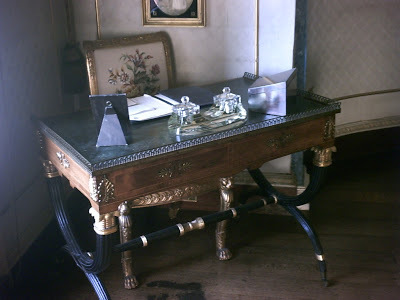
G is for Georgette Heyer
Georgette Heyer is the reason I am writing this blog. Had it not been for discovering her books when I was about eleven or twelve, I probably would not be where I am today. She is the Queen of Regency and although she dismissed her novels as ‘fluff’, you would be hard put to find better written romantic novels. I love her style and wit, her masterly descriptions and the sense of fun her novels convey. When you laugh out loud at a book, it can only be a winner. May I proffer humble thanks, ma’am.
H is for Horses
One of the best things about historical novels is the horses. Although they are probably more revered today, being much-loved by millions of adoring owners throughout the world, in bygone times they were a necessity. Without horses, Knights could not have ridden into battle, stage-coaches could not have carried passengers and other items, and produce could not have been carried about the country. I have spent my equestrian hours riding astride and much of that time in the pursuit of dressage perfection, the most elegant of equestrian pursuits. Nevertheless, there is no more elegant sight than a lady in a beautiful habit, riding side-saddle. Horses in themselves are romantic. Even the lowliest Dobbin has his own grace and majesty. Take those most noble of Georgian breeds, the Arabian and the Thoroughbred, and you have fire, beauty, courage, loyalty and intelligence besides. And I’m not just saying that because I love horses.
The Horse by Ronald Duncan
Where in this wide world can man find nobility without pride,Friendship without envy,Or beauty without vanity?Here, where grace is served with muscle And strength by gentleness confined He serves without servility; he has fought without enmity. There is nothing so powerful, nothing less violent. There is nothing so quick, nothing more patient. England's past has been borne on his back. All our history is in his industry. We are his heirs, he our inheritance.
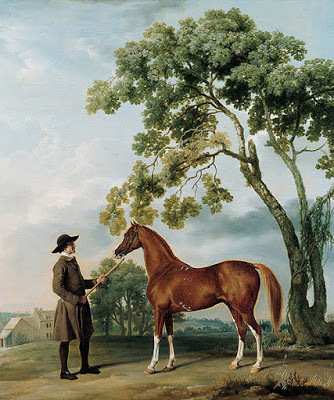 Lord Grosvenor's Arabian Stallion with a Groom
Lord Grosvenor's Arabian Stallion with a GroomGeorge Stubbs
H is for HEA
I admit it. I am a sucker for a happy ending. While there can be an emotional satisfaction in a sad conclusion to a story, if that is what the plot demands, I do like to see my characters happily settled at the end of a novel and I prefer to read books with either a happy ‘ah’ ending or a witty one. Georgette Heyer was particularly adept at the latter and it always left me with a warm feeling. I try to do that with my own stories, because romantic historical fiction should be about escapism. We have enough reality in this modern world.
I is for Interiors
I love visiting a stately home and seeing a room decorated as it would have been in eras gone by. It is fascinating, especially when it is done in Regency style. Old buildings have an amazing atmosphere. Although a ruin, Witley Court in Worcestershire has the most wonderful feel of secrets and ghosts from times long past. Many years ago I was lucky enough to visit Salzburg in Austria, where the fortress is alive with the spirits of previous centuries. (No, I’m no madder than any other writer, honest!) I try and convey this to my readers through my writing, because for me, romance is not only about the love story.
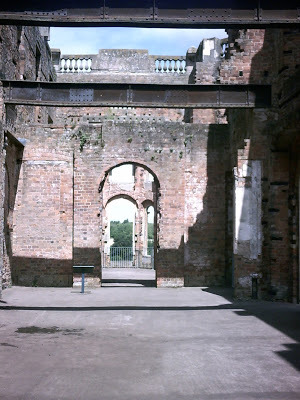 Ballroom, Witley Court
Ballroom, Witley Court
J is for Jane Austen
What Regency author doesn’t love Jane Austen’s works? She was, of course, writing about her own time and did not invent the Regency genre. Georgette Heyer can be credited with that. However, Jane has bequeathed us so many gems of insight, custom and historical detail. From her works we know the modern delight in contracting words in dialogue (one of my bête noirs in historical novels) is not accurate. She gave us the wicked romp in Lydia and the serene beauty in Jane. She gave us the intelligent, independently minded heroine in Elizabeth and the interfering one in Emma. She also gave us the toe-curling Mr. Collins, the wonderful Colonel Brandon and the worst marriage proposal in English literature! Thanks to Auntie Beeb and Andrew Davies, though, I can no longer read Pride and Prejudice without thinking of Colin Firth and that scene…
 Darcy's shirt
Darcy's shirtL is for Losing myself in another world
As I’ve already mentioned, one of the beauties of reading or writing historical fiction is the opportunity to become so immersed in another era that time loses all meaning and everyday pressures and worries cease to exist – at least while you are in that world. If a book can do that for me, it is a true romance in the best tradition.
L is for LOVE
Love. One of the strongest emotions, it comes in so many forms: Love of life, a subject, a place, a view; love of family, of friends, of pets… and of that one special person in your life. Love is all you need sang the Beatles and they weren’t far wrong. Love makes the world go round. Within the pages of novels from the Circulating Libraries, ladies of the Regency found solace from their humdrum lives and loveless marriages. Nowadays, we buy romance novels by the zillion, just for the sheer pleasure of that perfect, joyful connection with another person. There are few more satisfying feelings than reaching the end of a wonderful book with a happy ending. That warm, fuzzy sensation is love in itself.

M is for Manners and Courtesy
I am a traditionalist, and appreciate it when a gentleman holds open a door for me or a child says please and thank you. I’m aware I am a dying breed and yes, I am perfectly capable of opening my own door, but it is nice to have it done for me. It is nice when a gentleman helps you out of a car (or down from a carriage!) It is nice to be escorted on a proffered arm and treated with old-fashioned courtesy. It is particularly nice when the gentleman next door mows your front verge with his ride-on mower to save you having to struggle with your old electric one! I love that about Regency novels, that even when people were insulting each other, it was couched in such a manner as to be civil, rather than screaming abuse heavily littered with profanity.
N is for Names
There have been lots of great names throughout the centuries which are now virtually obsolete. Joscelin, for a man, is one of my favourites and finally found its owner in the hero of Carpet of Snowdrops. There is a certain romantic beauty in many old names, I feel… although perhaps not Godfrey, Wat or Alf!
O is for Original
Heroines must have something about them. They must be strong and engaging and preferably have some trait or quirk which makes them unique. That strength need not mean they are independent and headstrong, but that they can deal with whatever ‘life’ throws at them in a fashion which is enjoyable to read. They must also behave in a manner befitting the era they live in. If a Regency heroine talks and behaves in the manner of a modern miss, it throws me out of the story. It is part of the charm and romance of an historical novel to discover how the heroine can claim her hero without overstepping the bounds and mores of the time.
P is for Posting Houses and Coaching Inns
I just love old inns, especially if they still have their original stable yards! I am fascinated by the history of them; the stories of past landlords and noble (or well-known) patrons, of smugglers and highwaymen, of ghosts and crimes. I am also fascinated by the growth of such buildings and how they became famous. Romance comes in so many forms.
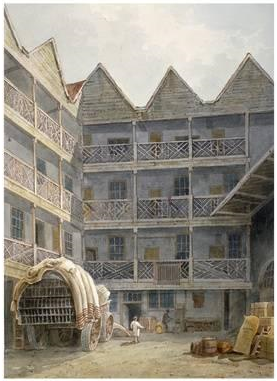 Yard at Bull and Mouth, St. Martin's le Grand,
Yard at Bull and Mouth, St. Martin's le Grand,George Shepherd 1817
R is for Rakes and Rogues
What reader of historical romance doesn’t love a rake or a rogue? This article would not be complete without them! I admit I do have a soft spot for one – provided he has some redeeming features, loves his lady and is reformed (or at least faithful) by the end of the book. He must be tender as well as masterful and recognize his shortcomings. After all, a gentleman with experience is better set to please his bride! Perhaps my favourite literary rake is Damerel in Georgette Heyer’s Venetia.
S is for Social History
Well-written and well-researched novels are a fascinating window on the way people lived in a previous time – and what a great way to learn! This is one of the best of the many facets of Georgette Heyer and Jane Austen novels: the historical detail. I love to know what people ate, drank, slept in, sat on, used, wore and did for recreation and entertainment. I’m just a nosey so-and-so!
S is for Stables
Horsemastership has essentially changed very little over the centuries. With the advent of the motor car, however, many country houses reduced their stabling or converted into garaging. During the Victorian era, traditional stalls were lost, with loose boxes becoming more prevalent. The now-accustomed ‘half door’ looking on to a quadrangle was yet to become the norm, so beware, authors of Georgian and Regency fiction! Most horses of those times were stabled in stalls, the size dependent on the animal’s breeding and status. Nothing, however, can be more romantic, in an equestrian sense, than a line of heads looking out on to a cobbled yard, ears pricked and nickering (not whickering, that’s American) for breakfast.
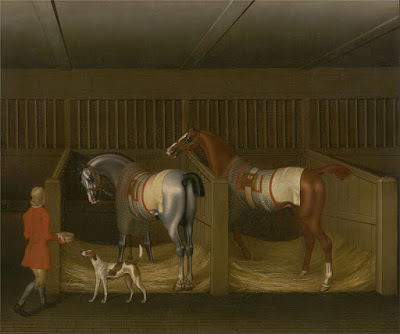 The Stables and Two Famous Running Horses,
The Stables and Two Famous Running Horses,James Seymour
T is for Tattersall’s
As a horse lover, a visit to London isn’t complete without a look-in at Hyde Park Corner and a walk down Rotten Row. The most famous horse sales and bloodstock agency in the world began life here, founded in the 1770s by Richard Tattersall. The Duke of Kingston’s former groom and trainer rented land behind St. George’s Hospital, close to the Corner. It quickly became the place to be seen among gentlemen with an interest in equestrian matters, as well as the place to buy and sell horses. A weekly sale was held and ‘Black Monday’ became the not always humorous nomenclature for Settling Day. It meant the ruin of many an aristocratic name. Tattersall’s is one of the must-see places for young Johnny Raws from the country in any Regency novel.
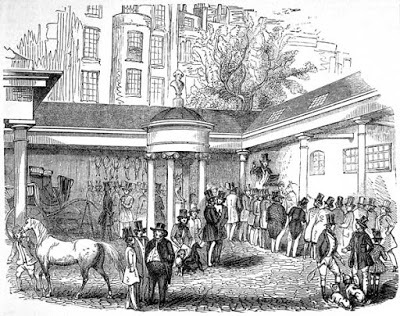 Tattersalls, Hyde Park Corner, 1842
Tattersalls, Hyde Park Corner, 1842V is for Vauxhall Gardens
What can be more romantic than a trip down the river to Vauxhall for the characters in an historical novel? Picture the shadowed paths, the tree-lined walks, the music playing and figures bedecked in their finery, flitting like butterflies and chattering like sparrows. It is the perfect setting for a clandestine meeting, a risqué masquerade or an elegant concert followed by supper and a romantic walk along the lantern-lit paths. Such intrigues can be envisaged, such dastardly actions performed, and all for the stroke of pen or press of keypad… Vauxhall was made for romantic fiction!
W is for Witty Dialogue
Of all the elements of good Regency fiction, possibly the one I like best is the witty dialogue. While Jane Austen had an acerbic wit, Georgette Heyer was the grande dame of the concept in her novels. I laugh aloud when I am reading her books and that does not happen with many authors. I love it when I find someone who writes with that same sense of humour. Of course, beside JA and GH, the rest of we poor mortals can but aspire.
This is one of my favourite quotes and comes from Faro's Daughter, first published by Wm. Heinemann Ltd. in 1941.
"You will find it very inconvenient to keep me in your cellar indefinitely, I imagine, but I must warn you I have not the smallest intention of leaving it, except upon my own terms."
"But you cannot let the race go like that!" cried Deborah, aghast.
"Oh, have you backed me to win?" he said mockingly. "So much the worse for you, my girl!"
© Heather King
All photographs © Heather KingOther images Public Domain

Published on April 17, 2018 06:48
April 1, 2018
Happy Easter!

Wherever you are in the world, whether you celebrate Easter as a religious festival or just enjoy chocolate, I should like to wish all my lovely readers and blog visitors
A Very Happy Easter!




A little pictorial flavour of Easter. I'm sorry I have been quiet lately but I am currently working on the next release, which will be published soon!
May you all have a lovely, peaceful and restful time.
Heather
All pictures are in the public domain.

Published on April 01, 2018 06:43
February 11, 2018
St. Valentine's Day
[image error]The Lover's Letter Box, George Baxter
Although the custom of giving lace-edged, heart-shaped cards to sweethearts and lovers is Victorian in origin, the association of the fourteenth of February with romance goes back a lot further than that. In Roman times it was the eve of Lupercalia, a pagan festival of youth and fertility. During the festival, those taking part chose their sweethearts by way of a lottery. Stripped naked, the young men ‘chastised’ their chosen women on the bottom with goat or dog-skin whips. This was supposed to improve fertility!
While actually unconnected with the celebrations and traditions of the day, St. Valentine – who was renowned for his chastity as well as supporting love and marriage – was martyred on this same date. In about AD 197, Valentine of Terni, a Christian and Bishop of Interamna (now Terni) was, it is thought, imprisoned for his faith on the orders of a Roman called Placid Furius (yes, really!) and tortured before being beheaded on the Via Flaminia in Rome. Legend has it he was executed on the fourteenth of February; in all probability, however, somebody thought it was too good an opportunity to miss.
In the reign of Emperor Claudius (about AD 289) another priest called Valentine, also a Christian, seems to have been arrested for giving relief to prisoners. Sundry, improbable, stories are attached to his name, where he variously converted his jailer to Christianity by healing the sight of the man’s daughter; fell in love with the daughter and sent her a love letter ‘From your Valentine’; and, when Claudius supposedly banned marriage among young men to make them better soldiers, Valentine was purported to have continued to perform weddings, thus leading to his arrest. Valentine of Rome is also said to have died on the fourteenth of February.
Approaching two hundred years later, in about AD 496, Gelasius, the Pope of that time, ordered that 14 February was to be a Christian feast day and would be named St. Valentine’s Day. This smacks rather strongly of the later claiming of the day following All Hallows’ Eve (Hallowe’en) by the Church as All Saints’ Day somewhere around 835. Originally introduced in May, to commemorate martyrs without a particular feast day, it was moved to the first of November to counteract paganism. The last day of the Celtic calendar, the 31st October was the date when the ancient ritual of Samhain was celebrated. Samhain thus became overshadowed by All Hallows' Eve and the Church took back an edge of control. Claim a pagan rite as your own and you not only save face, you can keep the people under your thumb!
It would seem that the connection with the giving of (generally) anonymous love-tokens stems from the belief held in medieval England and France, that the beginning of the second fortnight of the second month of the year was when the birds began to mate. In 1382, Chaucer wrote, in respect of the betrothal of Richard II to Anne of Bohemia, ‘For this was on St. Valentine's Day/ When every fowl cometh there to choose his mate.’ In the liturgical calendar of Valentine of Genoa, however, the saint’s day was the second of May – a more appropriate time for birds to mate in England. This is considered the first connection of St. Valentine’s Day with romantic love, nevertheless.
By 1601, the feast day was enough of an entity for the Bard himself to have Ophelia lament, ‘For this was on St. Valentine's Day/ When every fowl cometh there to choose his mate.’ Two hundred and fifty years later, love-notes had become popular, and in 1797 was published The Young Man’s Valentine Writer, a guide to messages and verse for the aspiring lover.
As with all such festivals, traditions and customs have become synonymous with the occasion. The Roman introduction of chance into the choosing of a partner can be seen in the custom whereby the first member of the opposite sex one sees on the fourteenth is then said to be one’s Valentine.
Another custom slowly being lost in the mists of time is that where young girls put bay leaves beneath their pillows before going to bed on St. Valentine’s Day, in the hopes of dreaming of future husbands. Other games of divination included this popular one: Name(s) of the favoured one(s) were written on slips of paper, enclosed in balls of moist clay and then dropped into a bowl of water. The first piece of paper thus named to rise to the surface would reveal the future sweetheart. Once a girl had chosen her Valentine, he was honour bound to present her with a lover’s gift.
[image error]An Illicit Letter, Vittoio Reggianini
In the Regency era, lovers of all walks of life might exchange little hand-written billets douxor poems, and gentlemen would present posies of flowers to their sweethearts. Little gifts, of ribbons, lace, a book or perhaps a favourite sweetmeat, were considered unexceptionable tokens of affection, although these were not confined to St. Valentine’s Day. That custom had begun to fade as far previously as the mid eighteenth century, although still continued in parts of Northern England. Nonetheless, as the nineteenth century progressed and postal distribution became more accessible to ordinary folk, anonymous cards were possible. Manufactories began to mass-produce tokens for St. Valentine’s Day, and the downward spiral into commercialism had begun.
All pictures Public Domain
© Heather King

Published on February 11, 2018 16:20
December 24, 2017
Regency Festive Fare
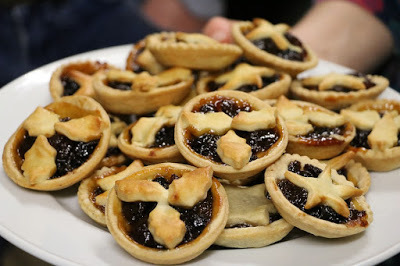
Mince Pie
Are you ready for a mince pie? This perennial favourite, you may be astonished to learn (or not), was once actually made with meat. Known in England for centuries, the original combination of beef (or neat’s tongue) and dried fruit has gradually evolved into the individual fruit pies we know today. Here are two recipes from The London Art of Cookery by John Farley, 1811. The first is with meat, the second without.
TAKE a neat's tongue, and boil it two hours; then skin it, and chop it as small as possible. Chop very small three pounds of beef suet, the same quantity of good baking apples, four pounds of currants clean washed, picked, and well dried before the fire, a pound of jar raisins stoned and chopped small, and a pound of powder sugar. Mix them all together with half an ounce of mace, the same quantity of grated nutmeg, a quarter of an ounce of cloves, the same quantity of cinnamon, and a pint of French brandy. Make a rich puff paste, and as the pattypans are filled, put in a little candied citron and orange cut in little pieces. Put close down in a pot what mincemeat is left, and cover it up; but never put any citron or orange to it till wanted for use.
Or, shred three pounds of suet very fine, and chopped as small as possible. Take two pounds of raisins stoned, and chopped as fine as possible; two pounds of currants nicely picked, washed, rubbed, and dried at the fire; half a hundred of fine pippins pared, cored, and chopped small; half a pound of fine sugar pounded fine; a quarter of an ounce of mace, the same quantity of cloves, and two large nutmegs, all beat fine. Put all together into a great pan, and mix them well together with half a pint of brandy, and the same quantity of sack. Put it close down into a stone pan, and it will keep good for months.
Yorkshire Christmas Pie No Yorkshire gentleman in Georgian times would have suffered Christmas without this indulgence. It was a good way of showing prosperity. The pie was made from whatever birds were available on the estate and comprised a three to five bird roast which was then encased in pastry. A common combination was chicken, pheasant and pigeon, all of which were boned and then stuffed inside each other. Particularly in Yorkshire, this was often given as a gift.
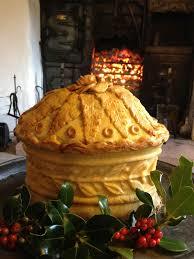 Christmas Pie
Christmas PieA more elaborate version of this dish caused the great bustard to be driven to extinction in Britain by the 1840s. Great bustards were prized for their flavour and cost about two guineas each in the first years of the nineteenth century. French chef Grimod de la Reyniere included in his book of that time, L’Almanach des Gourmands, a now famous recipe incorporating the bustard. It began with an olive stuffed with capers and anchovies, which was pushed into a garden warbler. This was then put into an ortolan, followed by a lark, a thrush, a quail, a larded lapwing, a plover, a red-legged partridge, a woodcock, a teal, a guinea fowl, a duck, a fattened pullet, a pheasant, a turkey and finally the bustard, each time the whole being placed into the larger bird. The stuffed bustard was then cooked in a sealed pot with ham, carrots, onions, celery, herbs, spices and lard for twenty-four hours. It was the kind of dish which would have graced one of the Prince Regent’s grand banquets.
In Carpet of Snowdrops, Joscelin brings a Christmas Pie for Eloise and Goody. Goody is somewhat tickled:
“Christmas joy to you, too, Goody. I have a gift for you as well.” Joscelin handed over the basket.As Goody removed the blue and white cloth, a small gasp escaped her.“Christmas Pie, what a treat! Thank you.”“I had my cook prepare it for you this morning.”Eloise screwed up her nose at the large domed pie. It had golden pastry decorated with crimped edges and elaborate pastry leaves and berries.“What is in it?”“Pigeon, chicken and pheasant, each bird being used to stuff the next in size,” Joscelin answered.“My mouth is watering already,” Goody put in with a smile. “If you have no objection, my lord, step into the kitchen. I have some mulled wine heating.”“I will be there directly. There is one more gift for you both. I will fetch it in.”He went back outside, returning almost immediately with a small fir tree.“Whatever have you brought that in for?” Goody demanded, reappearing with a steaming glass in her hand.“I spent some time in a Prussian camp after Waterloo,” he explained. “It is a tradition in Prussia to bring a tree into the house and hang decorations on it. I also read somewhere that Queen Charlotte caused one to be put up at a children’s party a few years ago.”“What a delightful idea!”
Here is a recipe from the time:
HAVING made a good standing crust, with the wall and bottom very thick, take and
bone a turkey, a goose, a fowl, a partridge, and a pigeon. Season them well, and
take half an ounce of mace, the same quantity of nutmegs, a quarter of an ounce of
cloves, and half an ounce of black pepper, all beat fine together. Then add two large
spoonsful of salt: mix all well together. Open the fowls all down the back, and bone,
first the pigeon, then the partridge, and cover them. Then proceed in the same manner
with the fowl, goose, and turkey, which must be large. Season them all well, and then
lay them in the crust, so that it may look only like a whole turkey. Then have a hare
ready
cased, and wiped with a clean cloth. Disjoint the hare into pieces, season it, and lay it as close as possible on one side; and
on the other side put woodcocks, moor-game, and any sort of wild fowl. Season them well,
and lay them close. Put at least four pounds of butter into the pie, and then lay on the lid,
which must be very thick, and let it be well baked. It must have a very hot oven, and will
take four hours baking at least. This crust will take a bushel of flour.Plum Cake
No Christmas is complete without cake. The forerunner of the present day Christmas Cake, this was first known as plum porridge and dates back to the beginning of Christianity. The porridge evolved into a cake long before the sixteenth century. To a pound and a half of fine flour, well dried, put the same quantity of butter, three quarters of a pound of currants washed and well picked; stone and slice half a pound of raisins, eighteen ounces of sugar beat and sifted, and fourteen eggs, leaving out half the whites; shred the peel of a large lemon exceeding fine, three ounces of candied orange, the; same of lemon, a tea spoonful of beaten mace, half a nutmeg grated, a tea-cupful of brandy, or white wine, and four spoonsful of orange flower. First work the butter with the hand to a cream, then beat the sugar well in, whisk the eggs for half an hour, then mix them with the sugar and butter, and put in the flour and spices. The whole will take an hour and a half beating. When the oven is ready, mix in lightly the brandy, fruit, and sweetmeats, then put it into the hoop, and bake it two hours and a half.
 (Half) Pound Cake (C) Heather King
(Half) Pound Cake (C) Heather KingThis cake, based on a traditional recipe, uses approximately half a pound of each ingredient and is far less complicated than the Regency receipt quoted above.
Whatever you are eating this Yuletide, I wish you a joyful and peaceful Christmas, and Best Wishes for the New Year.
Happy Christmas!
All images public domain unless otherwise stated.
(C) Heather King
Apologies for formatting ~ having issues correcting.

Published on December 24, 2017 06:02
December 8, 2017
Yuletide
As Christmas approaches, I take a look at some Regency customs and food.
Yule was originally the name of a pagan midwinter feast lasting twelve days. Nowadays Yuletide is an old word for Christmas, although the name was still used in Scotland and the North of England in the latter decades of the twentieth century. The festival lends its name to various traditional items.

Yule Log
Most of us are familiar with the 'Yule Log'. Originally, this was an enormous bough of a tree, felled and brought into the house with great care and ceremony – various strictures had to be obeyed, such as handling it with clean hands – and it was lit on Christmas Eve with a fragment of the previous year’s log. It was considered bad luck for it to go out, so it had to be large enough to burn for the Twelve Days of Christmas. It was also considered bad luck for it to be touched by a barefooted woman or a visitor with flat feet! Today, it is more often served in the form of a cake, usually a Swiss Roll covered in chocolate buttercream icing.
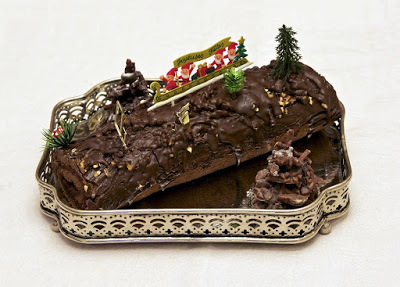
Yule Candle
The 'Yule Candle' is one with a garland of winter foliage. It must be large enough to last the whole of Christmas Day or else bad luck will befall.
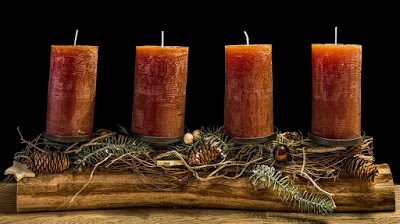
Yule Dough
'Yule Dough' or 'Yule Cake' was a kind of bread, made from white wheat flour, yeast, lard, brown sugar, currants, egg and sweet spice. This was made in the shape of a baby in many parts of the British Isles. In his ‘Observations on Popular Antiquities’ of 1777, John Brand states, “The Yule-Dough ... a Kind of Baby or little Image of Paste, which our Bakers used formerly to bake at this Season, and present to their Customers.” ‘Oop North’ in Yorkshire, each member of the family was given one.
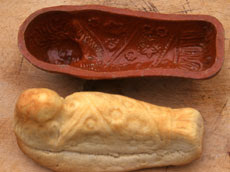 Yule Dough Mould
Yule Dough MouldA recipe from Cassell’s Dictionary of Cookery, 1892
Yorkshire Spice Cake (sometimes called Yule Cake).—These cakes are made in large quantities in Yorkshire families at Christmas time. They are freely offered to strangers and presented to friends, and are frequently eaten with cheese instead of bread.
Put eight pounds of flour into a bowl, and mix a tablespoonful of salt with it; then rub into it a pound and a half of butter, and two pounds of lard. Scoop a hole in the centre of the bread without touching the bottom, and pour in half a pint of fresh sweet brewer's yeast mixed with water. Stir flour into the yeast till it is like batter, sprinkle flour over the top, and set the bowl in a warm place.
When the yeast rises in bubbles through the flour, knead the dough thoroughly as for common bread, and let it rise till it is light. When risen, work in with it six pounds of currants, picked and dried thoroughly, three pounds of raw sugar, some grated nutmeg, and eight well-beaten eggs. Divide it into loaves of various sizes, put these into tins which they will half fill, lined with buttered paper, and bake the cakes in a well-heated oven. The yeast must on no account be bitter. Time to bake the cakes, according to size.
Yule Pudding
'Yule Pudding' is a custard-style concoction baked in a puff-pastry case like a tart.
Another recipe from Cassell’s Dictionary of Cookery, 1892
Yule Pudding.—A quarter of a pound of butter; ten ounces of loaf sugar; the juice of two large lemons, with the rinds grated; one ounce of isinglass—the quantity after dissolved should be a large tea-cupful; and two spoonfuls of fine flour. Put these ingredients into a stew pan, stir over a slow fire, till the preparation nearly boils, then throw it into a basin and stir till almost cold; then add eight eggs, four whites, and half a wine-glass of brandy. A puff' paste is to be put entirely over a dish, and the pudding is to be baked half an hour.
© Heather King

Published on December 08, 2017 13:13
November 29, 2017
The Historical Supper Clubproudly presentsA Regency Chris...
The Historical Supper Club
proudly presents
A Regency Christmas Ball
You are cordially invited to attendthis auspicious occasion atThe Historical Supper Club's Grand Historical Ballroom
Guest Authors, giveaways, articles,snippets of historical interest,excerpts and gamesAll eras are welcome.
THE TWELVE DAYS OF CHRISTMASinTWELVE HOURS
Beginning in the United Kingdom at 7.00pm GMTTravelling to the United States at 1.00am (8.00pm EDT)and Concluding in Australasia from about 4pm local time.
Do not miss this opportunity to mingle with characters from a wide range of historical genres!

R.S.V.P. Heather King: A Regency Repository

Published on November 29, 2017 12:41
November 4, 2017
The Gunpowder Plot
Remember, remember,
The Fifth of November,
Gunpowder, treason and plot.
For I see no reason
Why Gunpowder Treason,
Should ever be forgot.
Do you remember this nursery rhyme? In our house, we used to change ‘treason’ on the fifth line to ‘season’ because we just loved Fireworks Night!
Most people will be familiar with the story of the Gunpowder Plot, but where did the celebration come from? At the first sitting of Parliament following the discovery of the plot, in January 1606, an act was passed to commemorate this historic event. The Observance of 5th November Act 1605 ensured that sermons and services would be held annually to remind the general public of the consequences of such a heinous crime (or perhaps to emphasize the power of the establishment.) The torching of bonfires and the ringing of church bells to mark the day each year became tradition soon after Guy Fawkes and his co-conspirators were discovered and fireworks were an obvious inclusion to replicate the gunpowder from very early on.
Perhaps the most correct name for the celebration is Guy Fawkes Night, but it is also known as Bonfire Night and, as said above, Fireworks Night.
The origins seem to be lost in history, but it was once the custom for children to make a scarecrow-type figure by stuffing old clothes with straw or paper, either with a hand-drawn face or a mask, to represent Guy Fawkes. The ‘guy’ was then wheeled about in a cart or wheelbarrow with the object of collecting money from generous folk to buy fireworks, toffee and parkin or gingerbread. On 5th November, the guy was ceremoniously burned atop the bonfire.
Perhaps modern children, in these days of organized events, do not know of bonfire toffee and sticky gingerbread, nor yet have held a sparkler, but in this author’s youth, these things, along with sausages and jacket (baked) potatoes eaten around the fire were all part of the fun. A Catherine Wheel, a Roman Candle or two, a snow pyramid and perhaps a single rocket would be the sum total of our fireworks, but they have stayed in the memory. I wonder if today’s indulged youngsters will remember the noisy pyrotechnic displays and mass-produced burgers with the same affection.
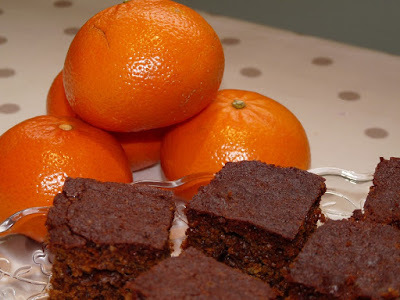 Gingerbread
GingerbreadThere was a great deal of civil and religious unrest during the seventeenth century. James I brought back and enforced the Act of Uniformity that required Roman Catholics to attend Protestant churches or be fined. Catholics were not allowed to celebrate Mass; going to church on Sunday was compulsory. During a conference at Hampton Court in 1604, an ‘authorized version’ of the Bible was ordered to be drawn up by eminent scholars and divines.
Under the leadership of Robert Catesby and Thomas Percy, a small group of Catholics got together to plan an outrageous counter-attack. If successful, it would blow up the King at the State Opening of Parliament on 5thNovember 1605. The plotters rented a cellar which lay beneath the House of Lords (it seems incredible now, doesn’t it?) and began storing firewood and barrels of gunpowder there. Guido (Guy) Fawkes had served with the Spanish army in the Netherlands and was both experienced and knowledgeable in the use of explosives.
 Plan of Old Palace of Westminster 1793-1823
Plan of Old Palace of Westminster 1793-1823The original conspirators were Guido Fawkes, Robert Catesby, John Wright, Thomas Wintour (Winter?) and Thomas Percy. Later recruits were Robert Keyes, Thomas Bates, Christopher Wright, John Grant, Robert Wintour (Winter?), Ambrose Rokewood, Everard Digby and Francis Tresham.
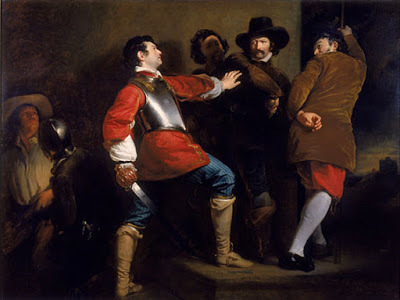 The Discovery of The Gunpowder Plot and the Taking of Guy Fawkes, Henry Perronet Briggs, c1823
The Discovery of The Gunpowder Plot and the Taking of Guy Fawkes, Henry Perronet Briggs, c1823One of the conspirators (possibly Francis Tresham), concerned that fellow Catholics present in the Lords would perish alongside those who were guilty. He sent a letter to William Parker, 4th Baron Monteagle: Retire yourself into the country… they shall receive a terrible blow this Parliament, and yet they shall not see who hurts them.’ The letter was passed to the authorities and thus, late on the night of 4th November the cellars were searched. Guy Fawkes was arrested while standing guard over his stash of gunpowder and then tortured. He endured hours on the rack, refusing to incriminate his friends. Nevertheless he and his accomplices eventually confessed. On 31st January 1606, having been tried and convicted of treason, Robert Wintour, Thomas Bates, John Grant and Everard Digby were dragged on litters to St. Paul’s Churchyard, where they were hung, drawn and quartered. Since that date, a ritual search of the cellars is conducted annually before the opening of Parliament. Guy Fawkes, along with Thomas Wintour, Robert Keyes and Ambrose Rookwood were executed in Old Palace Yard, Westminster, where Richard I, Coeur de Lion (by Marochetti, 1860) sits his rearing horse and where Sir Walter Raleigh also met, in elegant black velvet and with urbane courage, his own end.
 Thomas Wintour (Winter)
Thomas Wintour (Winter)Although Catesby and Percy escaped and thus avoided execution, their bodies were exhumed, thence to be decapitated. Their heads were then displayed on spikes before the Houses of Parliament. When Guy Fawkes was captured, the other conspirators fled. Many either had family connections with the present West Midlands or found succour among the Catholics residing in the area. Robert Wintour had been an obvious addition to the plot, since he had inherited Huddington Court, near Worcester, a place known to have hidden priests. Robert Catesby sent a letter via Thomas Bates to Father Henry Garnet and other Jesuit priests hidden by the Throckmorton family at Coughton Court. Stephen Littleton and Robert Wintour were captured at Hagley Hall, home of Humphrey Littleton, the brother of M.P. John Littleton, after a cook became suspicious at the quantity of food supposedly being eaten by his master. Although Humphrey denied the allegations, another servant betrayed the hiding place of the fugitives. Hindlip Hall near Worcester, home of Thomas Habingdon (Addington?), was ransacked by the authorities for four days; two starving Jesuit priests finally gave themselves up.
 Hindlip Hall, destroyed by fire 1820
Hindlip Hall, destroyed by fire 1820So, however you plan to celebrate Bonfire Night, stay safe and have fun – and spare a moment to remember those persecuted men driven to such desperate measures and, ultimately, such gruesome, cruel deaths.
All images public domain
© Heather King

Published on November 04, 2017 16:00



